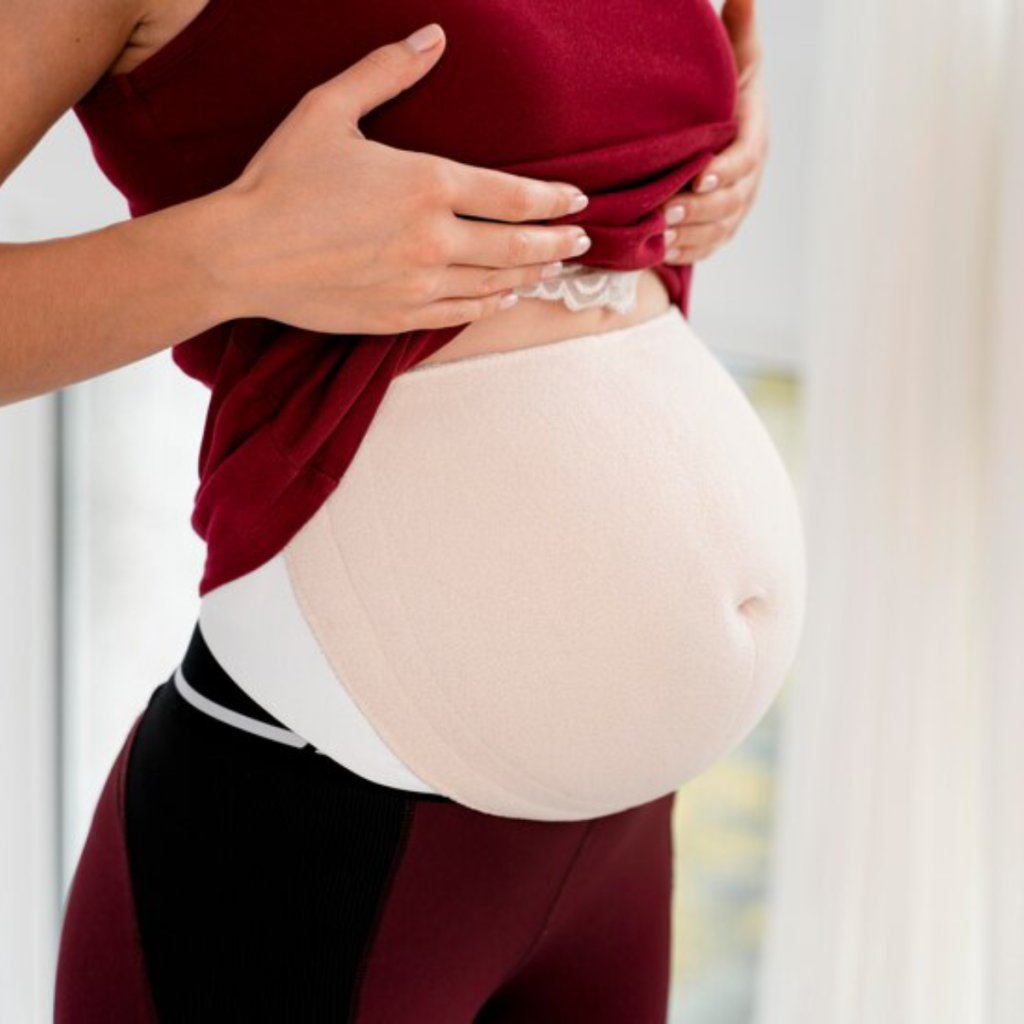Discover the potential risks and downsides of wearing a postpartum support belt or girdle.
Are There Any Risks or Downsides to Wearing a Postpartum Support Belt or Girdle?
Congratulations on your new addition to the family! As you navigate the incredible journey of postpartum recovery, you may come across many suggestions to aid in your healing process. One popular option that often pops up is the postpartum support belt or girdle. These nifty little accessories are touted as miracle workers, promising to provide comfort and help restore your pre-baby body. But are there any risks or downsides to wearing them? Let’s explore!

Understanding Postpartum Support Belts and Girdles
Before we delve into the potential risks, let’s get to know these postpartum helpers a little better. Postpartum support belts and girdles are specially designed garments that provide gentle compression to your abdominal area. They aim to support your healing muscles, reduce swelling, and provide a sense of security during the postpartum period.
But what exactly do these support belts and girdles do? Let’s explore their purpose in more detail.
The Purpose of Postpartum Support Belts
One of the main purposes of postpartum support belts is to provide stability for your abdominal muscles, which may have become weakened during pregnancy. As your baby grows, your abdominal muscles stretch to accommodate the growing uterus, and this can lead to muscle separation known as diastasis recti. By offering this extra support, the belts can help alleviate discomfort and improve your posture as you go about your daily activities.
Not only do postpartum support belts provide physical support, but they can also offer emotional support during the postpartum period. Many new mothers experience feelings of insecurity and anxiety about their post-baby bodies. Wearing a support belt can provide a sense of security and confidence, helping new moms feel more comfortable in their own skin.
Different Types of Postpartum Girdles
When it comes to postpartum support wear, one size doesn’t fit all. There are various types of postpartum girdles available, ranging from full-body garments to more targeted belts specifically for the abdomen. With options to suit different body shapes and personal preferences, you can find one that fits like a dream.
Some postpartum girdles are designed to be worn immediately after childbirth, providing maximum support during the initial recovery period. These girdles often have adjustable closures to accommodate changes in your body as it gradually returns to its pre-pregnancy shape.
Other types of postpartum support wear are designed for long-term use, providing ongoing support as your body continues to heal and adjust. These girdles are often made from breathable and stretchy materials, ensuring comfort throughout the day.
It’s worth noting that postpartum support belts and girdles are not a one-size-fits-all solution. It’s important to consult with your healthcare provider or a postpartum support specialist to determine the best type of support wear for your individual needs.
Now that we’ve explored the purpose and different types of postpartum support belts and girdles, it’s important to understand the potential risks and considerations associated with their use. Stay tuned for the next section where we will delve deeper into these aspects.
The Potential Risks of Wearing Postpartum Support Belts
While postpartum support belts and girdles can be helpful for many women, it’s essential to be aware of the potential risks they may pose. Let’s explore these risks in detail:
Physical Health Concerns
Some medical experts express concerns that excessive reliance on postpartum support wear may weaken your abdominal muscles over time. By excessively depending on external support, your core muscles may become lazy and rely on the belt rather than naturally regaining their strength.
It’s important to note that the purpose of postpartum support belts is to provide temporary relief and assistance during the recovery period. They should not be used as a long-term solution for abdominal muscle weakness. Gradually weaning off the belt and incorporating core-strengthening exercises is crucial to avoid muscle atrophy.
Additionally, experts caution that wearing postpartum support belts for extended periods may restrict your diaphragm and limit your lung capacity. Taking deep breaths is essential for your overall well-being and promoting lung function, so it’s crucial to strike a balance.
While postpartum support belts can provide comfort and stability, it’s important to listen to your body and give your muscles the opportunity to regain their strength naturally.
Psychological Impact
While the physical effects of postpartum support wear are important to consider, we mustn’t forget about the emotional impact. Some women may find wearing these belts or girdles constantly a constant reminder of their changed bodies, which may contribute to feelings of self-consciousness.
It’s essential to prioritize your mental well-being too! Remember that your body has just gone through an incredible journey of pregnancy and childbirth. Embracing and accepting the changes in your body is a beautiful part of the postpartum experience.
If wearing a postpartum support belt makes you feel uncomfortable or self-conscious, it’s perfectly okay to explore alternative methods of recovery. There are various exercises and techniques that can help strengthen your core muscles without the need for external support.
Remember, postpartum recovery is a unique journey for every woman, both physically and emotionally. It’s important to find what works best for you and prioritize your overall well-being.
The Possible Downsides of Using Postpartum Girdles
In addition to the potential risks mentioned above, there are some practical downsides you should be aware of when it comes to using postpartum girdles:
Comfort and Convenience Issues
Let’s face it: postpartum life is already filled with enough sleepless nights and endless diaper changes. The last thing you need is discomfort caused by a poorly fitted or overly restrictive girdle. It’s crucial to find a balance between support and comfort to ensure you can move and function freely while wearing it.
When choosing a postpartum girdle, consider the material it is made of. Some girdles are made from breathable fabrics that allow for better airflow, reducing the chances of irritation or discomfort. Additionally, adjustable closures and straps can help you customize the fit to your changing body, providing the support you need without sacrificing comfort.
Furthermore, constant readjustment can be a hassle when wearing a girdle. It’s important to find one that stays in place and doesn’t require frequent repositioning. The last thing you want is to be constantly pulling up or adjusting your girdle while trying to take care of your newborn.
For women who have undergone a c-section, the discomfort around the incision area can be a significant concern. Some girdles are designed with special features, such as a cutout or adjustable panels, to accommodate c-section incisions and provide targeted support without causing additional discomfort.
Another practical issue to consider is the restricted bathroom breaks that can come with wearing a postpartum girdle. While some girdles have convenient openings or hooks that allow for easy access, others may require you to remove the entire garment, which can be time-consuming and inconvenient, especially when you’re already juggling the demands of a newborn.
Unrealistic Expectations and Body Image
As much as we’d love to snap back to our pre-pregnancy bodies instantly, the truth is that each postpartum journey is unique. While postpartum support wear can help provide a sense of security and confidence, it’s important to have realistic expectations about your body’s recovery process.
It’s common for new mothers to compare themselves to celebrities or influencers who seem to have effortlessly regained their pre-baby figures within weeks. However, it’s crucial to remember that these individuals often have access to a team of professionals, including personal trainers and nutritionists, who help them achieve those results.
Instead of focusing solely on getting back to your pre-pregnancy weight or shape, embrace the changes your body has gone through and celebrate the incredible feat of growing and birthing a tiny human. Your body has accomplished something extraordinary, and it deserves love, care, and acceptance at every step of the postpartum journey.
While postpartum girdles can provide support and help you feel more confident, it’s essential to prioritize your physical and mental well-being above all else. Remember that your body is unique, and the recovery process takes time. Be patient with yourself, listen to your body’s needs, and seek professional guidance if you have any concerns.

Medical Opinions on Postpartum Support Wear
Now that we’ve examined the potential risks and downsides, let’s take a look at what healthcare professionals have to say about postpartum support wear:
Views from Obstetricians and Gynecologists
Many obstetricians and gynecologists recommend postpartum support wear, acknowledging its benefits for certain women. However, they emphasize the importance of using these garments as a complementary tool, alongside other postpartum recovery practices.
Postpartum support wear, such as belts and girdles, can provide much-needed support to the abdominal muscles and pelvic area after childbirth. These garments are designed to offer gentle compression, which can help alleviate discomfort and provide stability to the weakened muscles. Additionally, they can assist in reducing swelling and promoting proper posture, which is essential during the recovery period.
Consulting with your healthcare provider is crucial as they can assess your specific needs and guide you on the best course of action for your postpartum recovery journey. They will take into consideration factors such as the type of delivery, any complications during childbirth, and your overall health to determine if postpartum support wear is suitable for you.
Perspectives from Physiotherapists
Physiotherapists often have their own take on postpartum support belts and girdles. Some believe that gentle compression can offer support during the early stages of recovery. However, they also emphasize the significance of gradually transitioning to self-supported exercises and regularly engaging the core muscles to regain strength naturally.
While postpartum support wear can provide initial support and comfort, physiotherapists recommend incorporating exercises that target the abdominal and pelvic floor muscles. These exercises, such as gentle pelvic tilts, Kegels, and deep abdominal breathing, can aid in strengthening the muscles and promoting overall recovery.
Remember, every body is unique, and professional advice tailored to your needs is invaluable in making the best decision for your postpartum well-being. Physiotherapists can provide personalized guidance and create a customized exercise plan that takes into account your specific needs and goals.
It’s important to note that postpartum support wear is not a one-size-fits-all solution. The duration of use may vary depending on individual circumstances. Some women may find that they benefit from wearing these garments for a few weeks, while others may continue using them for a longer period. Your healthcare provider or physiotherapist can help determine the appropriate duration of use based on your progress and recovery.
Alternatives to Postpartum Support Belts and Girdles
If the potential risks or downsides of postpartum support wear have left you uncertain, fear not – there are alternatives worth considering:
Natural Recovery and Healing
Your body is an incredible source of strength and resilience. Opting for a more natural approach, such as practicing gentle postpartum exercises, prioritizing nutrition, and getting sufficient rest, can encourage your body’s natural healing process.
Take the time to listen to your body and focus on overall wellness. Remember, recovery is a marathon, not a sprint!
Safe Exercises for Postpartum Recovery
Engaging in safe postpartum exercises, approved by your healthcare provider or a qualified professional, can play a significant role in rebuilding your core strength. From gentle yoga routines to pelvic floor exercises, there are many options available that can aid in your recovery journey.
Remember, it’s essential to start slowly and gradually increase the intensity as your body feels ready. Patience is key!
In conclusion, postpartum support belts and girdles can be helpful tools for postpartum recovery. However, it’s crucial to understand the potential risks and downsides associated with their use. Balancing the benefits with your individual needs and preferences is essential for a successful postpartum journey. Remember, be kind to yourself, listen to your body, and embrace the incredible strength that comes with motherhood!



